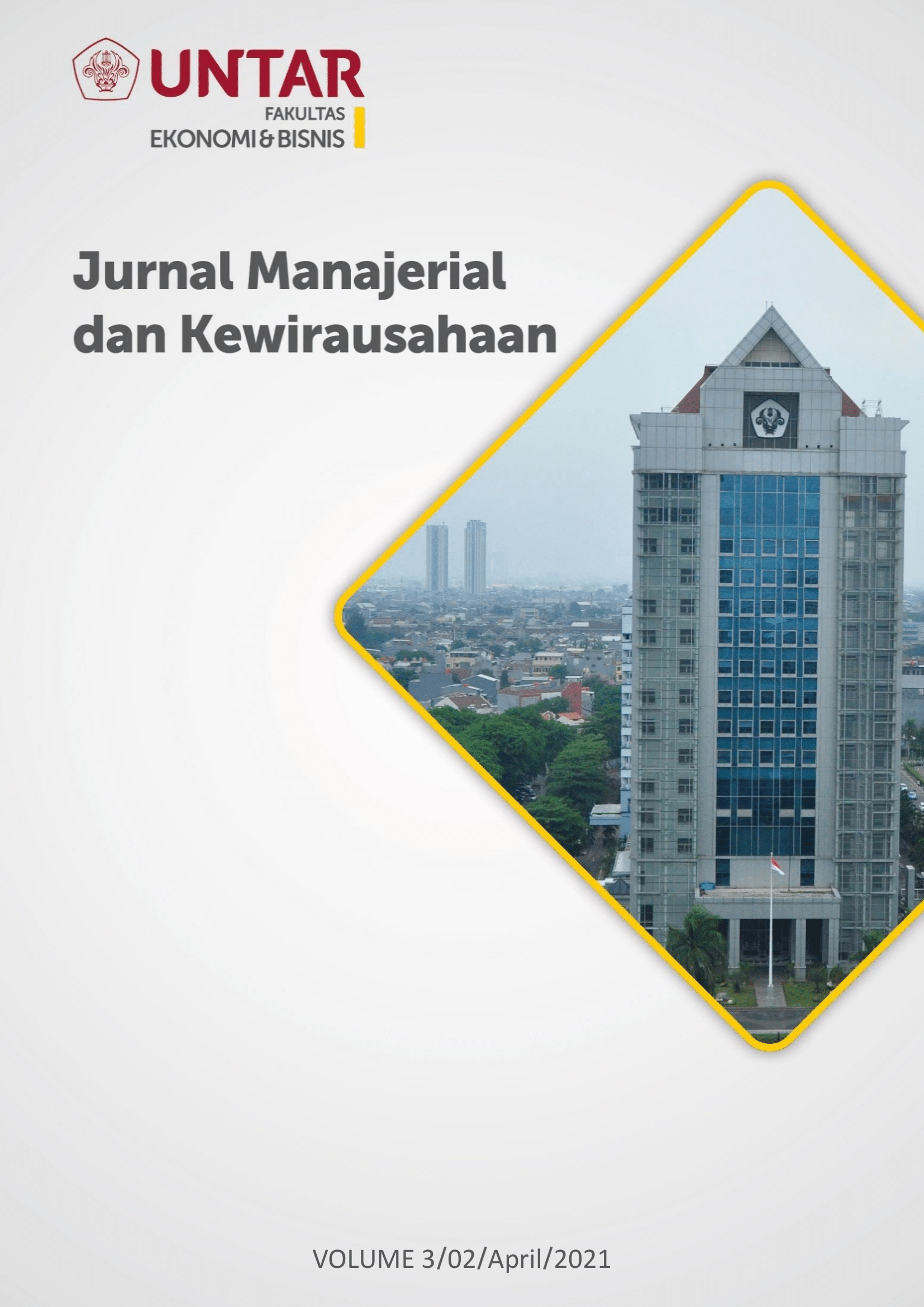Faktor-Faktor Yang Memprediksi Purchase Intention Skin Care Garnier Di Indonesia
Main Article Content
Abstract
Brand awareness is the consumer's ability to remember a brand, brand association is a positive / negative perception when remembering a brand, perceived quality is a customer evaluation of brand superiority, brand loyalty is a customer commitment to a brand, and purchase intention is an evaluation of consumers to decide to buy a product. This study aims to determine the predictions of brand awareness, brand association, perceived quality and brand loyalty to purchase intention with a conclusive quantitative method and a cross-section study. Data obtained by means of a survey made with "google form" sent via e-mail and WhatsApp to 100 respondents who are people who have used the Garnier brand skin care for at least 3 years in Indonesia with a non-probability sampling method (purposive sampling). Then there are 4 hypotheses in this study which were analyzed using PLS-SEM with SmartPLS 3. The results of this study indicate that brand awareness, brand association, perceived quality and brand loyalty each predict positively the purchase intention of Garnier brand skin care users in Indonesia.
Brand awareness merupakan kemampuan konsumen untuk mengingat merek, brand association merupakan persepsi positif/negatif ketika mengingat merek, perceived quality merupakan evaluasi pelanggan pada keunggulan merek, brand loyalty komitmen pelanggan pada merek, dan purchase intention merupakan evaluasi konsumen untuk memutuskan beli produk. Penelitian ini bertujuan untuk mengetahui prediksi brand awareness, brand association, perceived quality dan brand loyalty terhadap purchase intention dengan metode kuantitatif berjenis konklusif dan cross-sectiona study. Data diperoleh dengan cara survei yang dibuat dengan “google form” yang dikirimkan melalui email dan whatsapp terhadap 100 responden yang merupakan orang yang menggunakan skin care merek Garnier minimal 3 tahun di Indonesia dengan metode non-probability sampling (purposive sampling). Kemudian terdapat 4 hipotesis pada penelitian ini yang dianalisis menggunakan PLS-SEM dengan SmartPLS 3. Hasil penelitian ini menunjukkan bahwa brand awareness, brand association, perceived quality dan brand loyalty masing-masing memprediksi positif purchase intention pengguna skin care merek Garnier di Indonesia.
Article Details
This work is licensed under a Jurnal Muara Ilmu Ekonomi dan Bisnis Creative Commons Attribution-ShareAlike 4.0 International License.,/p>
References
Aaker, D. A. (1991). Managing brand equity: Capitalizing on the value of a brand Name. New York: The Free Press, Macmilla.
Ajzen, I. (1991). The theory of planned behavior. Organizational Behavior and Human Decision Process, 50, 171-211.
EIBN Sector Reports. (2019). New sector reports cosmetics. EIBN. EU-Indonesia Business Network. Diakses pada (2020, Oktober 9). Dari: www.eibn.org.
Evans, M., Jamal, A. and Foxall, G. (2006). Consumer Behaviour. UK: John Wiley and Sons.
Garson, G. D. (2016). Partial least squares: regression & structural equation models. North Carolina: Statistical Associates Publishing.
Ghozali, I. dan Latan, H. (2014). Structural equation modeling, metode alternatif dengan Partial Least Square (PLS). Edisi 4. Semarang: Badan Penerbit Universitas Diponegoro.
Hair Jr, J. F., Black, W. C., Babin, B. J., & Anderson, R. E. (2011). Multivariate data analysis 7th Edition. New Jersey: Pearson Prentice Hall.
Hoang, P. V., Nguyen, G. T., Phung, H. T. T., Ho, V. T., & Phan, N. T. (2020). The relationship between brand equity and intention to buy: the case of convenience stores. Independent Journal of Management & Production, 11(2), 434-449.
Keller, K. L. (1993). Conceptalizing, measuring, and managing customer-based brand equity. Journal of Marketing, 57(1), 1-22.
Kotler, P. and Keller, K. L. (2006). Marketing management, 12th ed. New Delhi: Prentice Hall of India.
Lee, Jia En., Goh, Mei Ling., dan Noor, M.N.B.M. (2019). Understanding purchase intention of university students towards skin care products. PSU Research Review, 3(3), 161-178.
MacDonald, E. K. and Sharp, B. M. (2000). Brand awareness effects on consumer decision making for a common, repeat purchase product: a replication. Journal of Business Research, 48(1), 5-15.
Malhotra, N. K. (2010). Essentials of marketing research. England: Pearson Educated Limited.
Malhotra, N. K. (2015) Essentials of Marketing Research. Harlow: Pearson Education Limited.
Mao, Y., Lai, Y., Luo, Y., Liu, S., Du, Y., Zhou, J., ... & Bonaiuto, M. (2020). Apple or Huawei: understanding flow, brand image, brand identity, brand personality and purchase intention of smartphone. Sustainability, 12(8), 1-22.
Nielsen. (2018, Oktober 29). Consumers don’t always take skin care claims at face value. Nielsen.com. diakses pada (2020, Oktober 23). Dari: https://www.nielsen.com/us/en/insights/article/2018/consumers-dont-always-takeskin-care-claims-at-face-value1/.
Pike, S., Bianchi, C., Kerr, G., & Patti, C. (2010). Consumer-based brand equity for Australia as a long-haul tourism destination in an emerging market. International Marketing Review, 27(4), 434-449.
Sekaran, U., & Bougie, R. (2013). Research Methods for Business. 6th ed. Italy: Printer Trento Srl.
Top brand award. (2019). Top brand pembersih wajah bukan sabun. Topbrand-award.com. diakses pada (2020, November 2) Dari: https://www.topbrandaward.com/en/2019/04/pembersih-wajah-bukan-sabun/.
Top brand award. (2019). Top brand sabun pembersih wajah. Topbrand-award.com. diakses pada (2020, November 1) Dari: https://www.topbrand-award.com/en/2019/04/sabunpembersih-wajah/.
Top brand award. (2020). Top brand krim pemutih. Topbrand-award.com. diakses pada (2020, November 2) Dari: https://www.topbrand-award.com/2020/04/top-brandindex-tracking-krim-pemutih/.
Wetzels, M., Odekerken-Schroder, G., & Oppen, C. (2009). Using PLS Path modelling for assessing hierarchical construct models: guidelines and empirical illustration. Assessing Hierarchical Construct Models. 33(1), 177-195.
Yaseen, S., & Mazahir, I. (2019). Impact of corporate credibility, brand awareness, brand image and brand loyalty on purchase intention in the telecommunication sector of Karachi. Global Management Journal for Academic & Corporate Studies, 9(1), 86-99.



